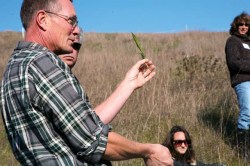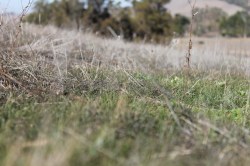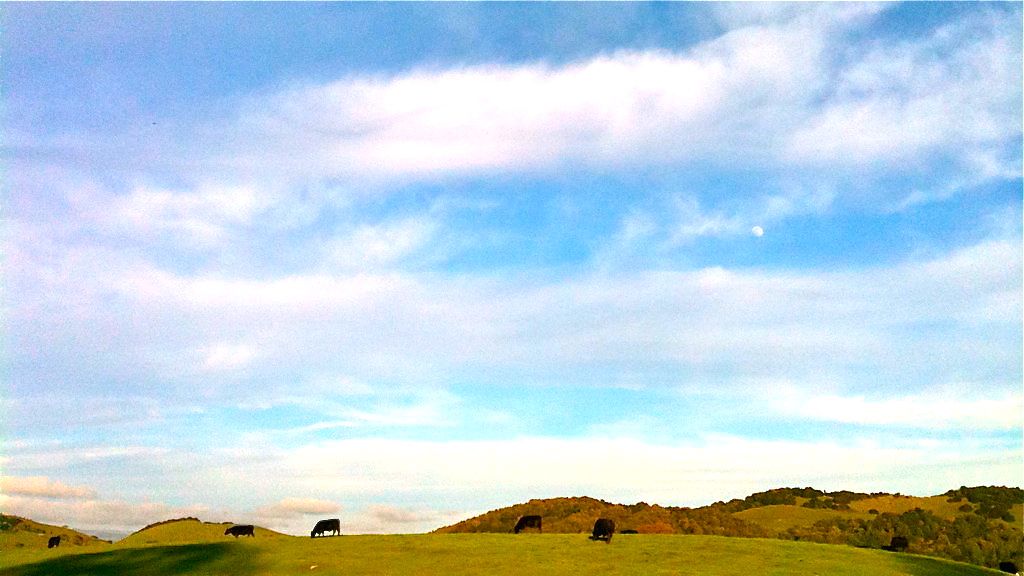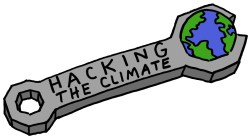John Wick’s battered blue jeans, wire-rimmed glasses, and plaid work shirt make him look like a stereotypical rancher, but he is not. He’s a philanthropist, and he runs cattle on his 540-acre ranch in Northern California not for money or beef production, but instead to try to promote native grass species by mimicking grazing habits of the elk herds that once roamed these hills.
Through more than a decade of experimentation on his ranch, Wick has stumbled upon what may turn out to be a groundbreaking discovery: He’s found a way to manage grasslands that can curb climate change, while also providing multiple benefits to ranchers and to society.
Wick wasn’t always a climate activist. He worked as a carpenter and construction project manager, then married into the wealthy Rathmann family. (His father-in-law was the CEO of the massive biotech company Amgen.) When Wick and his wife, Peggy, moved out to their ranch 16 years ago, they were simply looking for more space for an art studio.
But in 2007, Wick started to worry about global warming. “I couldn’t sleep at night,” Wick says. “I was terrified.” Instead of letting these anxieties continue to paralyze him, he decided to do something about it.
Wick thought about the natural cycle he saw on his ranch. Plants grow by converting sunlight, water, and carbon dioxide into carbohydrates. Each blade of grass, he explains, is like a little straw that sucks carbon out of the air and into the plant’s tissues. When the roots eventually decompose, some of the organic material — made primarily of carbon — remains in the soil and becomes protected from further decomposition.
Was there a way, Wick wondered, to make grasses on rangelands amass more carbon, pulling it out of the atmosphere and sequestering it in the soil? Rangelands cover 770 million acres of the United States and make up about one-third of the planet’s ice-free land surface. If these ecosystems could be managed, on a large scale, to store more carbon, it would cause a notable reduction in global warming.
Wick assembled a crew of experts, from ranchers and agricultural agencies to scientists and policy-makers to help answer this question. “I called everybody who I could think of that would be at all interested,” Wick says.
Together they created the Marin Carbon Project.
![]()

Tom ForsterTom Wick, founder of the Marin Carbon Project
Wick convened a group of scientists at Lawrence Berkeley National Laboratory to discuss whether he could manage his ranch in a way that would extract carbon from the air and deposit it in the soil, and if so, how to measure it. Specifically, he wanted to know if spreading compost, a natural fertilizer, across the landscape could result in removal of more carbon from the air.
Wick’s presentation particularly intrigued Dr. Whendee Silver, a biogeochemist from the University of California, Berkeley. She had studied soil carbon in tropical forests and recognized that little was known about it in California. Silver’s team began doing controlled experiments to see how compost, in conjunction with cattle grazing, affects underground carbon storage and grass growth in rangelands.
The results of Silver’s experiments were encouraging. The areas where compost had been applied sequestered about 900 pounds of extra carbon per acre of land each year over comparable plots where none had been put. If this practice were scaled-up, Silver calculates that spreading half an inch of compost on half the grasslands in California would remove enough carbon from the atmosphere to balance out the greenhouse gas emissions from all the electricity use in California homes and businesses each year.
Aside from being good for the environment, applying compost to pastures was beneficial for business: It improved forage for cattle by increasing grass growth by 25 to 50 percent, causing the soil to retain 2,800 more gallons of water per acre, and making the pastures more resistant to drought.
“I get contacted by ranchers from all over the country who have heard about this, and who are interested in applying compost,” Silver says.
![]()

UC Berkeley biogeochemist Whendee Silver
Silver’s team was careful not to overlook unintended consequences.
For instance, would adding compost to grasslands cause soil microbes to produce additional powerful greenhouse gases such as methane or nitrous oxides? Not in rigorous lab tests, and not on the field plots they had studied.
Could invasive weed seeds hide in compost? Not if it was made properly: The heat of the composting process would kill almost all seeds.
By making rangelands more fertile, would more non-native plants take root and thrive there? These grasslands, like most in California, were already dominated by non-native grasses that were brought here in animal feed and by European colonists over 200 years ago. Silver found that putting compost on grazed rangelands didn’t increase the proportion of non-native to native grasses, and also didn’t increase the proportion of other invasive weeds like star thistle.
What about nutrient-rich runoff, which can cause algal blooms and dead zones in waterways? Silver said her team didn’t look specifically at this issue in their test plots, but that “the compost breaks down very very slowly so it is unlikely to have a negative effect on water quality.” In fact, compost reduces water runoff by increasing soil water-holding capacity, so it compares favorably to synthetic fertilizer or manure application.
And finally, and most importantly, what about all the greenhouse gases emitted by making compost, transporting it to fields, and spreading it? Would these carbon ‘costs’ outweigh the extra carbon stored in rangelands?
To answer this question, Silver’s lab group spent three years quantifying emissions from soil microbes’ response to compost, and analyzing greenhouse gas emissions from compost production and transportation, from changes in livestock food sources and digestion, and from waste management. Then they compared these emissions costs to the carbon savings from making compost and the carbon storage underground when compost was applied to rangelands, assuming the number of grazers on the land remained unchanged.
“Even being really conservative (in our estimates), the compost application came out ahead,” says Dr. Marcia DeLonge, a post-doctoral scholar working with Silver. “It was a climate-beneficial practice.”
DeLonge found that putting compost on rangelands was especially favorable for the climate if the compost was made from materials that would otherwise produce a lot of methane under traditional waste management practices, like liquefied manure or landfill-bound green waste. When composted, the breakdown of these same materials produced far less potent greenhouse gases.
Based on all the research they’ve done, Silver’s team is confident in their results. “Putting compost on grazed grasslands led to soil carbon sequestration and net greenhouse gas reduction,” DeLonge says.
And it wouldn’t work as well without the grazers. Grazing, in the appropriate duration and intensity, is key to the Marin Carbon Project’s approach to storing carbon in California rangelands. “If you don’t graze the grass you end up with a lot of dead thatch that increases fire danger,” Silver says. If it were to burn, the dry vegetation would release carbon to the atmosphere.
The positive effects, both for ranchers and for the climate, could last for decades. Applying compost to grasslands starts a positive chain reaction, DeLonge explains, where more plant growth leads to more carbon stored in soil, which in turn enables more plant growth.
She’s observed this cycle for the past five years, and predicts that the carbon benefits of a single compost application on a plot of land could continue for upwards of 30 years.
![]()

Green shoots in drought-ridden California
The Marin Carbon Project sources its compost from a small facility nestled in a bucolic valley close to Wick’s ranch. Six long windrows of compost steam in the dewy morning air. Made of cow manure from a nearby dairy and yard waste from local homes, this compost effectively recycles some material that otherwise may have been sent to a landfill. A three-foot long thermometer, plunged deep into one of the piles, ticks up to 140 degrees Fahrenheit. “It’s hot enough to cook a potato in there,” the facility manager says.
This particular compost is bound for three ranches in Marin that are now working with the Carbon Project to establish “carbon farm plans” on their properties. By putting compost on their fields, these ranchers will test the feasibility of Wick’s idea on a larger scale than Silver’s test plots.
If it turns out to be an effective method for storing carbon underground, putting compost on grasslands could transform ranching as well as waste management nationwide. Food scraps, no longer considered waste, would be sent to facilities where they could be made into compost and spread onto the land. Ranchers would become stewards not just of the land, but also the climate.
There’s certainly no shortage of unwanted organic material: According to the Environmental Protection Agency, of the 36 million tons of food scraps generated each year in the U.S., only about 5 percent is converted to compost. The rest wastes away in landfills, where it makes up more than 20 percent of trash and decomposes in an oxygen-free environment to produce methane, a greenhouse gas 25 times more potent than carbon dioxide.
Carbon farming on a large scale poses technical challenges, however. Buying compost and transporting it to rural pastures is expensive. “At the price that (compost) currently is, it would be very hard to get this project scaled up,” says DeLonge, though the increased forage production and drought-resilience of pastures may make the practice more cost-effective for ranchers in the long run.
In addition to the cost, many California rangelands are too steep or remote to drive on with a compost-laden dump truck. Because of that, Dr. Lynn Huntsinger, a rangeland ecologist and certified California rangeland manager who is not affiliated with the Marin Carbon Project, doubts putting compost on rangelands is a practical solution to climate change most of the time. “It’s really important to distinguish rangelands from what we might call ‘pasture,’” she says. “And I think (the Marin Carbon Project) is about pasture… In certain areas it could be a viable strategy. But probably not on the majority of arid rangelands.”
Even if we found a way to spread compost over rangelands on a large scale, it’s not clear that the effects would be the same elsewhere. A grassland in arid southern California is a distinct ecosystem from one in Marin, and a one-size-fits-all approach could be ineffective or even harmful. In a very dry landscape, compost might just desiccate and blow away. In some sensitive ecosystems, compost application could potentially alter native plant communities, many of which are uniquely adapted to thrive in infertile soils.
In an article published in Global Environmental Change, critics of the Carbon Project in the scientific community warn, “over-generalizing results (about carbon sequestration potential) from one rangeland type to another can lead to false expectations.”
![]()
Silver agrees that more research is needed to determine the potential for carbon sequestration in arid systems.
Wick, for his part, is determined to see his idea grow. Buoyed by the scientific stamp of approval that Silver’s research has lent to his project, he continues to meet with policy-makers and speak at conferences about the Carbon Project.
His next step is finding ways to pay ranchers for the extra carbon they sequester underground through their management practices. One idea is to sell “carbon offsets” to companies and individuals who want to make up for their own pollution. Another: Selling “climate-friendly” wool from sheep that graze on compost-fertilized pastures.
Many challenges remain for carbon storage in rangelands on a large scale. Meanwhile, the science shows that putting compost on pastures, at least in some parts of California, can provide significant benefits to the climate as well as to ranchers. “This whole system of using nature to try to help slow global warming is in the exploratory phases,” Silver says. “But people are definitely taking the steps to move forward with this.”




